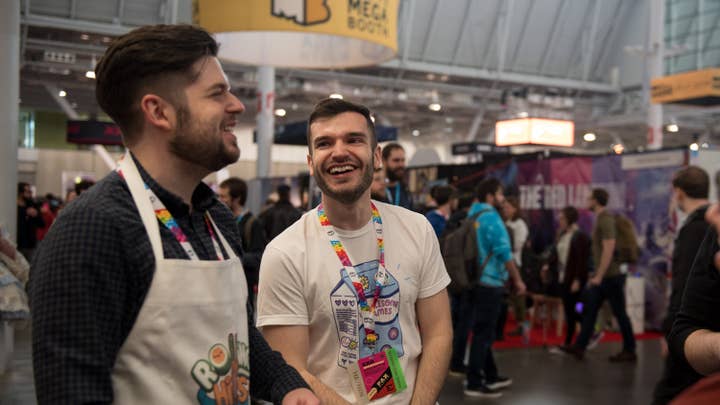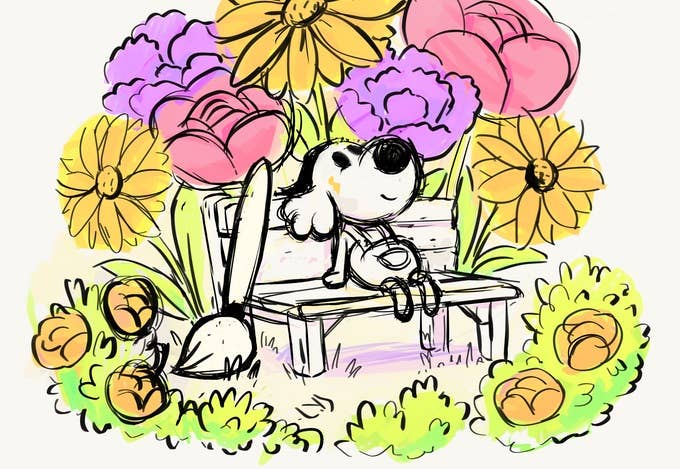Shaping a warm welcome for wholesome games
Matthew Taylor and James Tillman explain how the Wholesome Games Direct came about, and why curating games based on feeling was a success
In February of last year, Matthew Taylor made the Twitter account @_wholesomegames, just as a way to curate games he personally liked.
Within weeks, it had accrued a following, inspiring he and his colleagues James Tillman and Jacob Blommestein to start a Discord channel as a hub for the kinds of games they enjoyed.
At the time, the Wholesome Games team thought of it as a bit like a blog ring. They were all in a lot of different Discords for cute games that also had channels for developers to share their work, and Tillman noticed that it was a lot of the same people in all of these groups sharing the same games. Their Discord, he thought, would just be a way to connect all those folks more solidly across the different communities.
The Wholesome Games Discord gained 200 followers in a day and over 2000 in the following year and a half. The Twitter account now has over 40,000 followers and, earlier this year, the three curators partnered with over 50 developers to hold a digital showcase celebrating wholesome games: the Wholesome Games Direct.
Speaking to GamesIndustry.biz, Tillman and Taylor say that the rapid expansion from personal curation and blog ring-like community was a surprise, and very quickly resulted in the team being inundated with questions about what qualified a game as "wholesome" in the first place -- with them seen as sort of subject matter experts.
"We realized that whatever we said a wholesome game was would be what people think it stands for," Tillman says. "So we needed to be mindful. If we say this is about cute games, people will think that's what we care about. And we realized, with the community growing as quickly as it was, we had an opportunity to make it be about something more than fun and more than just distractions."
Tillman, Taylor, and Blommestein called on long-time community member Aurel d'Agostino to come up with the following criteria for games they would feature:
- Lower stakes
- Less violent
- Less stressful
- Positive themes
- Good representation of marginalized groups
- Friendly, welcoming aesthetics
"The last one is one I was on the fence about for a long time," Tillman says, "because I thought it was just like saying that cute games are wholesome, but there are lots of cute games that -- I don't want to dive into it, but I can think of a cute game off the top of my head that's morally disgusting to me.
"But what really drove that last one home for me was after the Wholesome Direct, there was a little bit of discourse about what these games are about, what the genre means. And someone went after one of the developers, saying like, 'You're just making cute stuff because it's easy to market and you're thinking you're going to get rich off of this.'
"We realized that whatever we said a wholesome game was would be what people think it stands for"
James Tillman
"And she had some really great responses about how the norm in the game industry is not cute and welcoming and gentle and peaceful and, frankly, feminine. She'd gone from publisher to publisher trying to get funding for her game. But because her game was those things, everyone would tell her, 'This doesn't really match our portfolio. We like it, but it just doesn't fit us.' So she came out saying that she felt the most rebellious thing she could do is make a game that is cute and gentle and welcoming in this environment. "
Tillman continues, noting that for Wholesome Games to feature something, it doesn't have to fit every one of the listed criteria. The team does have hard cut-offs: no hateful content, no bigotry, and no developers that have been toxic or abusive. But outside of that, those criteria are just something a game can strive for.
"Violence can be wholesome, frankly," he says. "We see what protesters around the country have done in the past couple of months. I would be the last person to say, 'Hey, calm down guys, this isn't wholesome.' Fighting for good things is wholesome. So we leave a spot for that."

Taylor later describes it as curating by a feeling, rather than by a genre.
"For me, if I go to Steam and I like Call of Duty or something, a similar game [might be recommended to you that] might not necessarily be another shooter. It'll be like, Madden. And that's because it's showing you as a certain kind of player, that enjoys these kinds of games. With wholesome games, you have a situation where there are farming games or platformers, and all this stuff. It's a really diverse [array of] genres.
"But when you talk to people about it, they'll say, 'I felt like every game was made for me.' And that's a little strange, because if you took normal genres, you would think if you're interested in the farming game, you're not interested in the platforming game. But when you curate them all by just a feeling and a theme, suddenly you realize that maybe those labels don't work as well as we think they do."
The Wholesome Direct took place in May, and came about after community members brought up frustrations that many of their games and games made by their colleagues would not receive the same kind of marketing they would have otherwise gotten, had COVID-19 not forced the cancellation of so many in-person events.
"I heard people saying that these are the games that would be in a montage at an E3 thing, but we gave them the whole [presentation]"
Matthew Taylor
And according to Taylor and Tillman, their little Direct that was put together with no funding and no hard objectives beyond showcasing a certain type of game was a success. Taylor shares that on average, games in the Direct received nearly 1,000 new wishlists in the following week. And feedback was positive as well, with developers and audience members alike sharing that they would have wanted the showcase to exist even if in-person events were still happening.
One developer told them that while they might have more individuals see their game in a single day at PAX, the people who watched the Wholesome Direct were already self-selected for the kind of people more likely to play their game. They compared it to the spike from a good day at a convention, but instead of a day's work for the team, it was a minute of video.
"Our audience is obviously smaller," Tillman says. "I think 100,000 people watched total. We had 16,000 live. But engagement as a percentage of that audience I think was a lot higher than almost any of the other showcases. So that's something interesting for people to consider going forward, really finding your audience. I know it's been said a million times that the internet creates a million niches. But I think we're gonna find out that this kind of game niche is a little bigger than people anticipate."
Taylor adds, "After the Direct I heard a lot of people say, 'I felt like this was made for me.' I heard people saying that these are the games that would be in a montage at an E3 thing, but we gave them the whole [presentation]. So I do think it's something that can and should exist beyond E3, but it started as simply as events being cancelled, and us seeing if we could help our friends."
Taylor also notes that the Wholesome Games community is exceptionally diverse, something that he and Tillman believe came about both naturally due to the kind of games they curated, but also due to specific rules protecting marginalized individuals and banning hatred and bigotry within it. And that diversity followed through in the developers who submitted their games and were showcased in the Direct. Approximately half of the teams shown in the Direct included at least one BIPOC core developer, not including contractors or interns, according to data Taylor shares. 79% included at least one woman core developer, and 37% included at least one non-binary core developer.
"The audience for these games has always been around, they just weren't catered to"
James Tillman
"We're just lucky to have this opportunity to do things that align with our beliefs," Tillman says. "I watched so many of the other showcases. And there was one that I watched and I went back to check the timestamps and it was nearly 50 minutes before anyone who wasn't a white man was shown on camera. And I thought, 'This is awful. They blew it with this.' And then I watched more and more and realized a lot of them are blowing this. This is really widespread.
"I think in the same way, if you show people a bunch of wholesome games, they might turn around and look at other games and think, 'This is really violent.' Maybe they've become desensitized to it. And maybe you can do a similar thing with representation, where you have a showcase and people go back and [are surprised]. Because we are so used to this in the games industry, whether it's violence or a lack of diversity, and I think showing what it can be like hopefully shines an uncomfortable spotlight on the ones that don't try."
Wholesome Games, despite starting as a whimsical Twitter account for personal curation, has plans to grow. Just last week, it hosted a miniature showcase called Wholesome Snack, and Taylor and Tillman say they would love to one day partner with Steam or eventual physical events like PAX or E3 to get more eyes on their developers. They also have hopes to get funding involved down the line, with the aim of supporting especially marginalized developers who wouldn't otherwise be able to attend those events.
"I see it as creating infrastructure," Tillman says. "If you look at the history of the games industry, so much of it for the past 30 to 40 years has been centered on selling violent games to young boys, and young white boys in particular. And you run into a feedback loop, because that's what we've invested in in the first place. That's what our research has gone into -- how to make games for this audience, and how to sell games to this audience. And when they are justifying what to invest in, they'll say we'll invest [in that type of game] because it's more of a sure thing.
"The audience for these games has always been around, they just weren't catered to. There's been a lot of discourse around Neopets and things like that, and how there have been big genres of games that get ignored by developers and publishers no matter how successful those games are in isolation. And I think it's that infrastructure problem. And it's the responsibility of people who have the opportunity to create infrastructure for selling these games and showing investors that this audience exists. They didn't just arrive. They've always been here, and yeah, they can be reached."



